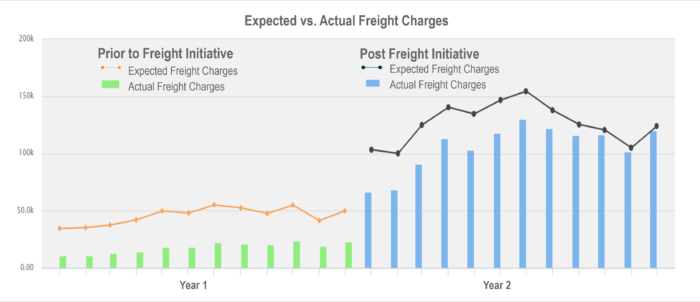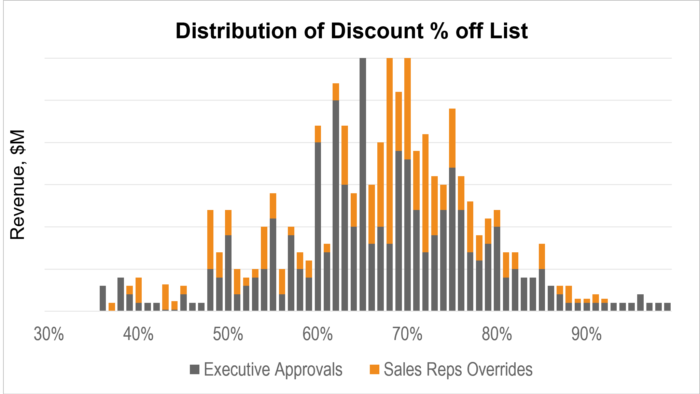Could You Be Leaving Profit on the Table? 4 Best Practices to Increase Price Realization

Price can be the most effective and profitable strategic lever in your business’s growth plan. However, setting and executing a pricing strategy that drives continuous profit improvement comes with challenges. In order to leverage strategic pricing to provide the most value to your customers – and your business – you need to understand the optimal methods necessary to ensure you realize the most profitable results possible.
Price realization is the difference between the amount of price your business has captured versus the amount you expected to capture. There are many reasons why an actual price may not match the expected price. You can spend all the time and resources in the world crafting a perfect pricing strategy, but if the customer rejects your price, it’s all for nought. Successful price realization that drives better ROI comes from a set of pricing guidelines and disciplines that, when put in place, maximizes the results from your pricing strategy.
At INSIGHT, our goal is to create impact. When we develop tailored pricing solutions for our clients, we do so with the intent of generating real bottom-line results as quickly as possible. While price setting is the cornerstone to successful price management, you also need to ensure your products and services are actually sold at that price. Regardless of the price you believe you’ve set with your customers, the true measure of profitability comes from the amount of revenue you actually captured.
To help your business navigate the complexities of price realization, we’ve outlined 4 best practices that will boost your ability to implement a pricing strategy that drives profit growth.
1. Understand Your Market Position and Value
Before you can start implementing price realization strategies, you should first understand if your current prices and commercial strategies accurately represent the value you are delivering to your customers. Price, as well as accompanying commercial terms, should be set at a reasonable and profitable level where the buyer and the seller are mutually benefited. If your price isn’t market relevant, or you aren’t aligned on the value you’re delivering, it doesn’t matter how good your sales or customer service teams are – your ability to successfully sell that product or service will decline, weakening target growth plans.
Conducting market research studies and evaluating the profitability of existing pricing strategies can help inform your market position and value. It can also bring light to areas of your business where unwarranted price leaks or price overrides are damaging your business’s value proposition and bottom line profits.
2. Develop Internal and External Communication Plans
How you communicate price is just as important, if not more, than setting the price itself. To achieve successful price realization rates, a business needs to build and execute plans to communicate price internally, then externally. This includes price changes as well as quoting new customers.
Internal Communication Plan
Whether conducting price changes or establishing pricing for new customers, internal alignment is the first step in communicating and executing a pricing strategy. This includes the executive team, sales team, product team, marketing team, and anyone involved in understanding and selling your product or service. A good team functions with a common goal – whether that’s higher margin %, increased revenue, or better win rates. Without an established and understood common objective, you risk individual contributors making decisions that support their personal goals or perceptions rather than working together with a common purpose.
In the case of price changes, internal alignment also requires a clear understanding of why those price changes are happening. Providing this messaging – whether it’s competitive factors, market shifts, or value-based positioning – gives your team conviction and confidence when they start taking that messaging to the marketplace. It also ensures all customers are receiving similar messaging.
In all cases, your commercial team should be aligned on the value your products or services bring to the market, and the accompanying messaging to support that value.
External Communication Plan
Communicating price changes to customers can feel daunting. Properly preparing your sales teams can alleviate the stress going into tough conversations and provide clear guidance and expectations that build confidence. We suggest a two-fold approach:
- Customer Communication Toolkits
- Training & Practice
A customer communication toolkit contains materials that support conversations and ensures everyone is using the same messaging in the marketplace. It typically includes:
- Customer FAQs such as timelines, the why, and value communication points
- Customer letters or emails, and detailed pricing by customer / product / service
- Sales scripts to combat concerns and pushback
- Escalation paths to inform what will you accept and what will you not budge on in certain scenarios
- Break even calculators to determine the absolute minimum price you can offer a customer
- Customer scorecards to understand points of negotiation
Alongside the toolkit, companies should provide their sales organizations with training on when and how to use these materials, as well as the opportunity to practice utilizing the learnings and messaging prior to communicating externally. This often includes:
- Value-based selling practices
- Scenario role playing
- Strategic negotiation tactics & behavioral mindset training
- Line-by-line customer price reviews
Practicing beforehand boosts confidence for customer conversations and prepares the team with tools and steps to take when faced with uncertain situations. Ultimately, when the sales team is given a clear plan and the tools to execute that plan, this positively affects your price realization.
3. Tighten Pricing Guidelines and Price Overrides
To successfully sell a product or service at an expected price point, your sales organization should have processes and governance in place to communicate, negotiate, and sell to customers in ways that drive desired sales and revenue goals.
For many businesses, the price given to a customer is more complicated than just a number on a page. Factors affecting price include product/service costs, freight, rebates, promotions, loyalty programs, special discounts, and so on. Any one of these factors could be unintentionally misused when giving a price to a customer. Having pricing policies in place that outline when and how to deploy items like freight or discounts ensures everyone on the commercial team is utilizing the same predetermined set of rules and guidelines.
The first step is making sure a policy exists where it is warranted. For example, a freight policy would document which customers, regions, products, or other scenarios warrant a freight charge versus included freight. A rebates program might outline the number of purchases required for a rebate, and the rules around when and how those rebates are distributed.
The second step is setting up a quarterly to annual cadence to review your policies. Keep in mind that you may want to increase the review frequency in times of market volatility or sensitivity, as policies and processes may need to change to better suit the given environment.
Third, guarantee you have a way to measure the success of your pricing policies. This includes 1) team compliance to the policy, and 2) understanding if the policy is leading to successful growth or goal completion. It’s critical to build structure and functionality to continuously measure results, or there’s no way to understand how your pricing decisions are affecting your bottom line and where adjustments should be considered.
Let’s review two examples:
Freight Policy at a Consumer Products Manufacturer
The Situation: The company had an unclear, unenforced freight policy that led to misunderstanding when and how much to charge. Additionally, the company could not easily track impact or report real cost or revenue associated with freight.
The Solution: INSIGHT built a new, simplified freight policy that was easy to follow and enforce. We then put sales incentives in place to increase revenue, including regularly reporting results by salesperson. As a result, the Client saw an increase in freight revenue and closed the gap between expected and actual freight charges.
Discount Management at an Electrical Equipment Manufacturer
The Situation: The company had decentralized pricing autonomy, giving the sales team authority to make pricing decisions on their own. In addition, they had limited visibility to and support for discount recommendations based on existing guidelines. This resulted in high margin variation due to individual sales pricing decisions. The company believed their commission structure supported desired behavior to minimize unwarranted discounts, however, the data did not support this hypothesis.
The Solution: As a result, INSIGHT and the Client reset discount levels, then integrated the discount recommendation model into an existing pricing tool for sales team visibility. We also documented and embedded discount ceilings and approval workflows. Finally, INSIGHT updated the commission structure to support the discounting rules and included a commission calculator within each transaction so sales reps could understand how their sales price would affect their commission.
Read the full Discount Strategy Case Study
These two examples illustrate how clear pricing policies that support internal growth plans can enhance the sales team’s ability to execute on a pricing strategy, increase price realization, and provide fair and transparent customer expectations.
4. Build a Sustainable Pricing Governance Structure
Last, companies need to secure sustainable results both now and in the future to safeguard all the work you’ve done to increase ROI through price realization. This is done through:
- Deploying centralized systems and tools
- Establishing accountability across the team
To support these endeavors, a pricing center of excellence can act as a central hub for pricing rules, decisions, and accountability. For each type of pricing decision – quoting new business, compliance to a discounting policy, etc. – a pricing center of excellence can provide clear guidelines and objectives across the commercial team. These objectives may include:
- Managing the pricing model
- Setting the frequency and type of price changes
- Writing and communicating pricing policies
- Writing and communicating pricing approvals, including quotes or discounts
- Deploying pricing software and tools
- Deploying measurement structures
- Identifying price leaks and paths to reconcile
This group also helps determine what role the different people in your organization play in creating, supporting, or executing on various pricing activities. For example, who is accountable for providing a good customer quote? While the pricing team may be responsible for setting price, the sales team should be held accountable for executing on the expected price.
To support measurement and accountability, try creating scorecards by sales rep performance for managers to view individual metrics as well as aggregate best practices and areas of improvement as a group. These scorecards hold sales accountable to their actions, drive engagement, identify trends, and influence KPIs that propel improvement in business results.
Increase Price Realization with INSIGHT2PROFIT
Because price is such a profitable strategic lever in a business’s growth plan, efforts to realize price in the market shouldn’t be taken lightly. Businesses can invest endless time into developing the perfect pricing strategy for growth plans, but if a customer rejects your price, you’ll never experience your desired results.
INSIGHT can help make your pricing strategy come to life through tailored pricing solutions that increase your ROI and deliver profit impact to your bottom line. We understand that profit opportunities don’t exist in a vacuum, and solutions need to be deployed effectively to maximize price realization and impact. If you are looking for a partner to help increase your ROI, contact INSIGHT to learn more.




